Rare Steiff Pull Toy Rabbit Hase Bunny Wooden Wheels 2 IDs
$257.00 Original price was: $257.00.$96.99Current price is: $96.99.
- Quality You Can Count On
- 100% High-Quality Guarantee
- 7 days free returns
- We take quality seriously.

I have helped numerous “Hoppys” or hopping “Hasen” (their names depending on their birth dates) find new homes, but these same rabbits on wheels are very rare. Unlike his non-moving relatives, this rabbit was made only until the 1960s, and he retained the generic “Hase” description during his whole production. Technically, “Hase” translates to “hare” in English, but the accepted usage is “rabbit,” and I am keeping with that.
As was the case for his stationary cousins, the pull-toy Hase was made in three sizes. This guy is the middle, 14-cm size, and his article number, 1314 ex or 1314,10, would have reflected this. Because Hase’s eyes are glass and his button is the earlier version of raised script, with skinny letters, I am confident that he was born no later than 1964, but he might be as early as 1953. The 14-cm measurement is for Hase, himself, without his wheels; Hase is not far from the catalogue; he measures about 13 cm, or about 5 1/8 inches high from the bottom of his feet to the top of his head. If you measure from the tabletop, Hase is about 6 1/2 inches high. If horizontal space is a consideration for you, Hase’s wheeled carriage is 8 1/4 inches long.
Since I have mentioned his button, I will also tell you that Hase’s chest tag is in excellent, crisp condition, with a brown stain from the tarnish on the (working) bell that has rested on it all those decades. Since the bell hides the stain, it is no big deal.
Hase’s (wooden) wheels are eccentric (that is what the “ex” refers to in the earliest article number), meaning that the axles enter each wheel displaced from its geometric center, thus giving the carriage an up-and-down bobbing motion as it is pulled along. This mechanism works very well with Hase, whose feet are each lashed to the bar that actually does the bobbing up and down as the wheels roll. The connection of his left front foot was repaired. I have no idea why the repair was done in brown floss and not white, but this doesn’t matter since the attachment is under Hase’s foot and not visible from his upright standing position; it plays no role in my assessment of his condition.
One more word about the wheels, they are in reasonably good condition. There is some wear to the red paint, but this does little, if anything, to detract from Hase’s very nice presentation.
Hase, himself, is in very good condition, with nice coloring—including the black tips of his ears and the spot above his cute bunny tail—and full mohair coverage. He has some minor detractions, but I think he displays really well. I rate his condition absolutely, not “for his age.” I believe that is a meaningless statement, since you can find a pristine antique Steiff animal as well as one made only a few years ago who is in poor condition. If you want to bring age into it, Hase is in very good condition DESPITE his age (and play).
There is an isolated bare spot on Hase’s left shoulder; I am not sure what kind of injury this is; it does not look exactly like a moth nibble, but it is pretty much hidden by his bow. I am showing you a closeup in my fifth image. The spot is less than a square centimeter.
Now that I have mentioned Hase’s ribbon, I have both good and bad things to report about it. The bad is the fact that it is faded and discolored; I believe it was once salmon or coral colored. The good parts are that it has only minimal fraying, and it is still tacked to his neck.
I mentioned Hase’s early-style raised script button, and I am showing it along with a picture of the entire felt lining of his left ear. The felt is darkened to what I would call “ecru” from the white it was originally, but it still retains a touch of rose-colored airbrushing. There is a light brown stain on that ear, which is about 2 millimeters square. Like the replaced lashing of his front foot to the carriage, the stain makes no difference to Hase’s very nice display, since his ears pretty much rest on his back, with only their mohair tops in view. Minus the stain, the felt lining of Hase’s right ear is the same, so I am not showing you an image of it.
The only thing remaining to tell you is that Hase has all of his original whiskers—six on each side of his nose. And speaking of his nose, please notice the inset in my second composite image, where I show the nice rose-colored airbrushing that decorates the top and bottom of the red floss “X” depicting his nose and mouth.
I can’t think of anything else, but please write if you have a question. If you are a Steiff bunny fan or wheeled toy enthusiast, this is a not-to-be-missed opportunity. In additon, Hase can be part of your Easter display.
WHATEVER YOU DECIDE TO DO ABOUT HASE OR ANY OF MY OTHER STEIFF ITEMS, PLEASE BE SURE TO SEE THE ARTICLE I HAVE WRITTEN ABOUT STEIFF ID FRAUD—INCLUDING COUNTERFEIT CHEST TAGS—(AND OTHER IMPORTANT INFORMATION FOR COLLECTORS). YOU WILL FIND THE LINK ON THE BOTTOM RIGHT OF MY SHOP HOME PAGE UNDER “FAVORITE LINKS.” IF YOU HAVE NOT LOOKED AT IT RECENTLY, I UPDATED AND EXPANDED IT IN JANUARY, 2023.
| ITEM ID | RL-2361 |
|---|---|
| COLOR | Black, Brown, White |
| ITEM TYPE | Vintage |
| FINE PLUSH AGE | Post 1950 |









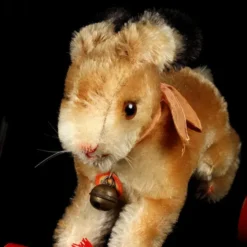








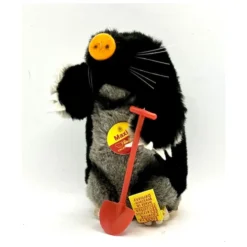

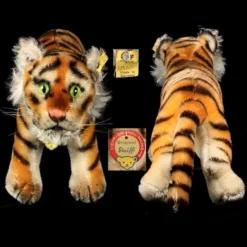




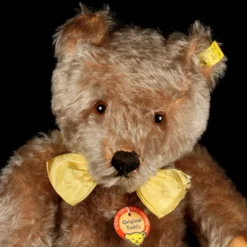

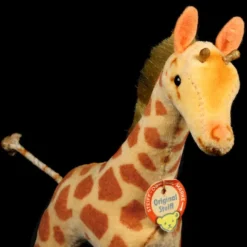



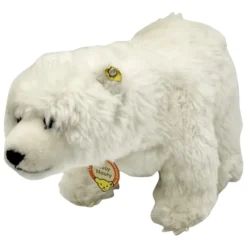
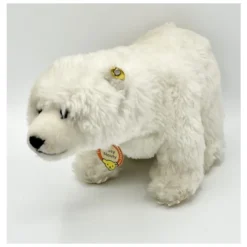
Reviews
There are no reviews yet.